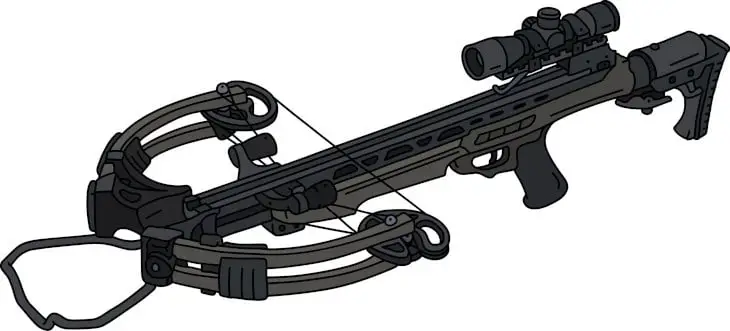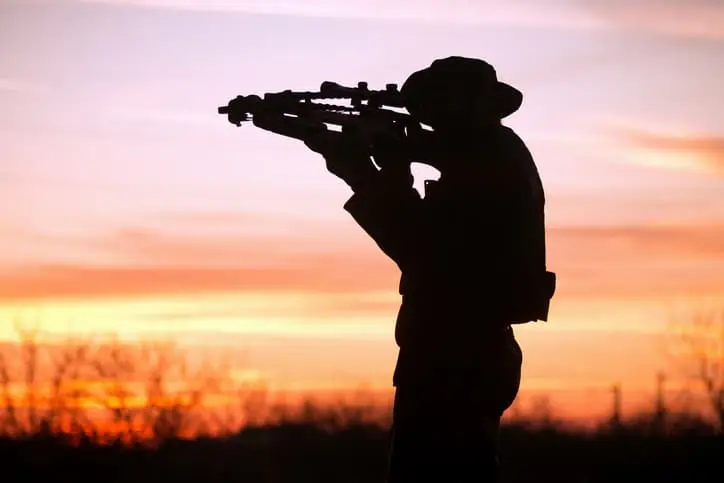In the world of archery, crossbows are—for lack of a better term—a little quirky. They have a lot in common with regular bows, but they have dozens of features that make them an entirely separate beast.
Draw weight is one of those features. The physics behind draw weight is the same for any type of bow, but because crossbows have a very unique shape—and an incredible amount of shooting power—their draw weight needs a little explaining.
So here we’ll go over the questions compound bow users usually have when it comes to crossbow draw weight: what it is, how much you can handle, and what you’ll need for the style of shooting you want to do. If you’re a target shooter, this will be pretty simple, and if you’re a bowhunter, we’ll go into a little bit more detail.
We’ll start at the beginning:

What Is Crossbow Draw Weight?
On any bow, from ancient longbows to the most modern crossbows, “draw weight” refers to the amount of force required to pull the bowstring back. For example, if a bow has 50 pounds of draw weight, drawing the bowstring is just as difficult as lifting a 50-pound dumbbell off the ground. On crossbows, you often hear draw weight referred to as “pull,” so a model with a 150-pound draw weight might be listed as having a “150-pound pull.” This is true for both compound crossbows and recurve crossbows.
For a crossbow user—or any archer of any type, really—the amount of draw weight is a vitally important feature to be aware of, because draw weight translates directly to how much power your crossbow is going to have when it shoots. The higher the draw weight, the more powerful the crossbow. Here’s how that works:
Bows and crossbows basically work like springs. You put energy into the bow by pulling the crossbow string back, and the higher the draw weight, the more difficult it is to pull the string back—and the more energy you put into the draw. When the string is fully stretched, the energy is stored in the limbs of the crossbow. Then, when you release the bowstring, you release this energy, and the limbs and bowstring spring forward and launch the arrow or crossbow bolt forward at high speeds.
While higher draw weight means more power and speed, the downside is that a higher draw weight makes it harder to pull the draw string back. Unlike vertical bows (meaning, recurve bows or compound bows—the types of bows we think of when we talk about bows), a crossbow has a latch and trigger system that holds the string back after you’ve drawn it. That’s a really cool feature, because if you’ve ever drawn the string on a regular bow—and had to hold the bow string back for a bit while you aim—you know how incredibly tiring that can get. The latch and trigger system allows crossbows to have much higher draw weights than vertical bows, and therefore more power, and they’re easier to use.
We’ll say that again, because it’s worth repeating: crossbows tend to have a much higher draw weight that regular recurve bows and compound bows. They’re harder to load, and they take more time to load, but that higher draw weight—and the ability to have them at full draw while the latch and trigger system holds the bow string back—make them a great option for bowhunting. There are plenty of folks who enjoy crossbows for recreational target shooting, but far away, but their most popular use is for bowhunting.
What’s the Range of Draw Weights on a Crossbow?
So now that you know the basics, let’s talk details—specifically, the exact draw weights you’ll see on a crossbow.
Crossbows come in all shapes and sizes, from miniature pistol crossbows that have much lower draw weights, to high-end/high-performing hunting crossbows that have incredibly high draw weights. Here’s how it breaks down:
The Low Side. Most crossbows are made with draw weights 80 pounds and higher. You can find a few with that are 50 pounds, but most are 80 pounds or more (and 80 pounds is on the lighter side of things—most crossbows out there are 100 pounds or more).
There’s a reason for that: Most crossbow manufacturers make their crossbows for hunting, and most states require bowhunters to use crossbows with at least 75 pounds of draw weight (more on that in a moment). Lightweight crossbows do have their uses, though, and they’re good for hunting small game (and if you’re looking for recommendations, we usually suggest the Tactical Crusader Hand Held Crossbow [affiliate link]).
The Medium- to High-Side. You’ll find a lot of crossbows with a draw weight of 125 pounds and 150 pounds, and on the upper end, you’ll find plenty at 175 pounds or 200 pounds. You will occasionally see a model with more than 200 pounds of draw weight (and if you can imagine picking up 200 pounds of weight, you’ll understand why!). Some modern specialized models can reach 290 pounds, but as that kind of draw weight is going to be really difficult to draw—even with a foot stirrup for leverage—those types crossbows require cranks or drawing aids.
That 290 pounds may sound absurdly high, but crossbows have nothing on the medieval monsters that sometimes reached as much as 1,500 pounds of draw weight. Of course, these were massive weapons made for siege warfare and required powerful cranks to draw. You won’t find them on the market today.
If you’re new to crossbows, we don’t recommend one with a super-high draw weight. There are a lot of great options, and we usually recommend the Barnett Whitetail Hunter II Crossbow (affiliate link). It’s got a reasonable draw weight and it’s relatively simple to use.
Can You Adjust the Draw Weight of a Crossbow?
We usually get this question from archers who use compound bows, which tend to have draw weights that you can increase or decrease.
Unfortunately, most crossbows don’t have adjustable draw weights. Crossbow limbs—and the bolts that connect them to the risers—are under much more pressure than on a vertical bow, and if you loosen any of the bolts to decrease the draw weight, they can’t hold the bow together as well anymore. Loosening the bolts to change the draw weight can severely damage the bow (so don’t do it!).
There are some models you can adjust, though, and manufacturers have come up with creative ways to do so. Some crossbow models have interchangeable limbs that can be switched out, and other have slider risers, where you can actually move the riser and limbs up and down the barrel and lock them into one of several different positions. Each position has a different draw length and weight, allowing you to significantly adjust the power and “feel” of the crossbow. Adjustable crossbows are rare, however, and the great majority of crossbow users stick to the regular, non-adjustable variety.
What Is the Right Draw Weight for Me?
Alright, now let’s talk about your situation. What should you be looking for?
We’ll split this section up into two parts, depending on how you want to use your crossbow.
If You Simply Want to Shoot a Crossbow Recreationally
This is the easy one: if you just want to use your crossbow for recreational purposes, like shooting at targets on your property, you can use whatever you’re comfortable with. Want a low draw weight? Go for it. Want a high draw weight? Go for it.
Just make sure that: 1) your target is designed specifically for crossbows, and 2) that you can comfortably pull the draw weight on the crossbow you’ve selected. The average adult male can pull a 150-pound crossbow without too much effort, but remember that doing so a number of times will tucker you out—even if you’re a big fit fella.
If You Want to Shoot a Crossbow for Hunting Purposes
Here’s where it gets complicated, but it’s really, really important: when you’re bowhunting, the draw weight on your crossbow you select must meet your state’s requirements for draw weights. The good people in your state’s Hunting and Fishing Department want to make sure that you’ll be using a crossbow with enough power to put your game quickly and efficiently, and they have rules—strictly enforced rules—and the draw weight you’ll need to use.
Most of the time, there’s a minimum draw weight that ranges somewhere from 75 pounds (which is the requirement in Maryland) to 125 pounds (which is the requirement in Washington). While there may also be a draw weight maximum, that’s less common (and if a maximum is stated, it’s usually around 200 pounds). If you want to go hunting, your crossbow will have to fall within this range, and you can get an idea of your state’s requirements here (keep in mind, that’s not primary source—you’ll need to check with your state for exact figures, as they can change from year to year).
With all that said… within the legal range of draw weights, more is generally better. All else being equal, higher draw weights mean more power and more speed, and that means you’re more likely to get your quarry and put it down quickly and painlessly. There may be reasons you might want a lower draw weight—smaller people, children, and senior citizens might have more trouble drawing heavier pulls—but higher draw weights are usually the better option.
How Much Draw Weight Can People Handle?
It’s really difficult to make generalizations like this, and usually we refrain from doing so, because we know big guys who can’t pull much draw weight and small women to can pull a surprising amount of draw weight, but…
Generally speaking, adult men can handle draw weights up to 175 pounds. Large men may even be able to draw crossbows over 200 pounds with adequate leverage. Women may have to drop down to 125 pounds or less, and children may need closer to 75 pounds (and even that might be a stretch for some of them).
Ultimately, you’ll need to experiment and see what you can handle. There’s really no way to accurately predict what a person can pull. And, remember—the more times you load your crossbow, the more tired out you’ll get. You may be able to handle a draw weight of 175 pounds, but doing so for an entire afternoon will get tiresome.
Crossbow Draw Weights for Hunting for Specific Types of Game
Before we discuss general draw weights, we feel compelled to say again, “Check with your state to see the appropriate draw weight.” They’ll have a list of the draw weight you’ll need for each type of game (deer, bears, etc.) and here’s a free pro-tip: if you’re having trouble navigating your state’s hunting website—and most of those websites were made a while ago and never really updated their tech—just call the state agency. They’re usually really knowledgeable and very helpful.
In theory, the minimum draw weight required by your state should be enough to take down most game. Bowhunters take down big game with compound bows and longbows and recurve bows all the time, and those weapons usually have draw weights lower than even the least powerful crossbows. In general, though, here’s how it shakes out:
Crossbow Draw Weight for Deer
A model in the range of 75 to 125 pounds is usually enough to put down a mule deer or whitetail, within the standard crossbow range of 40 yards. You can increase that range by getting a more powerful model, which could mean a draw weight of 150 pounds or more, and that can “save” a bad shot for you—it can power a less-than-perfect shot through muscle and tendon and sometimes bone.
Crossbow Draw Weight for Elk
Elk are whitetail deer’s larger cousin—in fact, they’re one of the largest specifies within the deer family—so it makes sense that you’ll need a more powerful crossbow to take them down. You’ll probably need at least 150 pounds, and 175 pounds is ideal if you can swing it. This is beginning to get into the range where even the strongest man will have trouble cocking the weapon without an aid, so keep in that in mind if you’re looking for a model in this range.
Crossbow Draw Weight for Bear
Bears vary widely in size from the smaller black bears in the east to the huge grizzlies and even larger Kodiaks out west. For small bears, the ideal draw weight is similar to that of elk. You need at least 150 but don’t be afraid to go higher. Grizzlies and Kodiak, however, fall into the biggest game category, so keep that in mind. Get the most powerful crossbow you can even if you need a crank. That probably means 200 pounds of draw weight or even more. Make sure to practice a lot on smaller game first, too.
You Should Take All These Estimates with a Grain of Salt…
If you’re familiar with state hunting laws, you may have noticed something: each one of these draw weight requirements is higher than the draw weight requirement on a vertical bow. In other words, the lower draw weight on a vertical bow is enough to put down game. Maryland, for example, will let you hunt a bear with a compound bow with a draw weight of at least 30 pounds, but requires you to use a crossbow with a draw weight of at least 75 pounds. Why is that?
Honestly, we don’t know the answer to that. It may be because state’s want you to utilize the great power of crossbows, because that greater power makes it more likely that you’ll put game down quickly and effectively, but that’s just a guess. If you have an idea, let us know!
Draw Weights: Final Thoughts
There you have it! That’s a pretty good intro to the world of crossbow draw weights. Now you know what they are, the range you can expect to see, and what you may be able to pull We hope that helps—good luck, be safe, and have fun!



